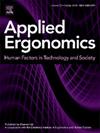Are the shapes and sizes of pen barrel the factors to influence handwriting kinetics?
IF 3.4
2区 工程技术
Q2 ENGINEERING, INDUSTRIAL
引用次数: 0
Abstract
Handwriting plays a vital role in children's learning. Choosing the correct writing tools, particularly in terms of pen shape and size, remains challenging. The influence of pen design on handwriting performance, particularly hand kinetics, is not fully understood. This study investigated how different pen shapes and sizes affect handwriting kinetics and performance in children and adults. Using a custom Force Acquisition Pen (FAP) system, the average force (AF), coefficient of variation of force (CVF), and force ratio (FR) were measured in 12 children (9.19 ± 0.97 years) and 18 adults (26.29 ± 3.21 years). Participants completed tracing tasks rather than free copying using circular and triangular pens with altered grip diameters (13, 17, and 21 mm), simulating the effect of different pen barrel thicknesses to standardize stroke paths and ensure consistency across trials. The findings revealed that, at smaller grip diameters (13 mm and 17 mm), triangular pens elicited lower FR values than circular pens in children. Adults showed more stable force control with a lower CVF across grip sizes. These results offer valuable guidance in selecting appropriate writing tools for children.
笔筒的形状和大小是影响书写动力学的因素吗?
书写在孩子的学习中起着至关重要的作用。选择正确的书写工具,特别是笔的形状和大小,仍然是一个挑战。钢笔设计对书写性能的影响,特别是手动力学,还没有完全了解。本研究调查了不同笔的形状和大小对儿童和成人书写动力学和表现的影响。采用自制的力采集笔(FAP)系统测量12例儿童(9.19±0.97岁)和18例成人(26.29±3.21岁)的平均力(AF)、力变异系数(CVF)和力比(FR)。参与者使用改变握柄直径(13、17和21毫米)的圆形和三角形笔完成描摹任务,而不是自由复制,模拟不同笔筒厚度的影响,以标准化笔画路径并确保试验的一致性。研究结果显示,在较小的握柄直径(13毫米和17毫米)下,三角形笔比圆形笔在儿童中引起的FR值更低。成年人在握力大小上表现出更稳定的力控制,CVF更低。这些结果为儿童选择合适的写作工具提供了有价值的指导。
本文章由计算机程序翻译,如有差异,请以英文原文为准。
求助全文
约1分钟内获得全文
求助全文
来源期刊

Applied Ergonomics
工程技术-工程:工业
CiteScore
7.50
自引率
9.40%
发文量
248
审稿时长
53 days
期刊介绍:
Applied Ergonomics is aimed at ergonomists and all those interested in applying ergonomics/human factors in the design, planning and management of technical and social systems at work or leisure. Readership is truly international with subscribers in over 50 countries. Professionals for whom Applied Ergonomics is of interest include: ergonomists, designers, industrial engineers, health and safety specialists, systems engineers, design engineers, organizational psychologists, occupational health specialists and human-computer interaction specialists.
 求助内容:
求助内容: 应助结果提醒方式:
应助结果提醒方式:


